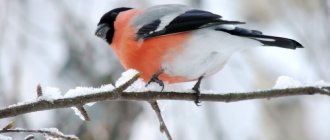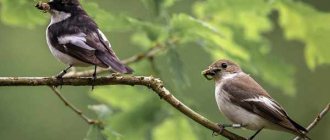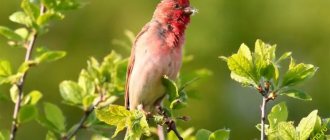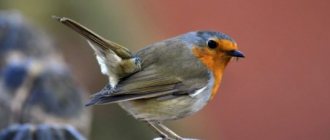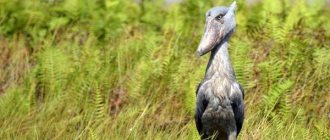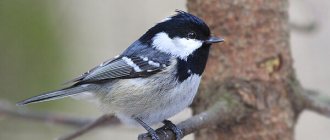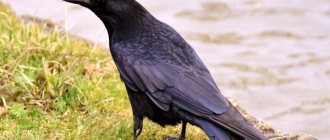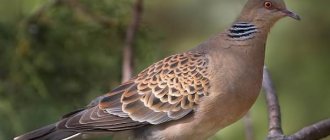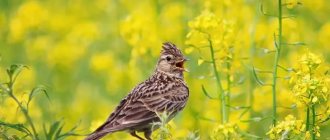- Reports and messages
- Birds
- Bullfinch - description of the bird
Winter nature opens up many amazing and charming places, but most importantly, beautiful birds appear that you cannot see in summer.
On bushes and trees that are neatly and beautifully covered with snow, you can spot handsome bullfinches. These wonderful birds live throughout Europe. They do not settle in the northern and southern regions, as well as near Japan and the Himalayas. Most of all, bullfinches prefer to occupy places among thickets of bushes, as well as among forests. Bullfinches are not very large birds. It weighs no more than 40 grams. Males differ from females in their beautiful and noticeable color. Their cheeks, neck and chest are red, while their head is black. Females are very similar to males, but they lack a red breast. In females it is gray. The thick beak of birds helps them easily get berries from branches and separate seeds from grains. In addition to the beautiful coloring of the bird, bullfinches are famous and attract the attention of passers-by with their song. The voice of the bullfinch cannot be compared with any other bird singing. The most interesting thing is that everyone in this family is talented. Both males and females perform their singing, this is how they differ.
Bullfinches are interesting birds; even in extreme cold they can eat berries on the branches and then sit motionless near them. This is how the bullfinch’s whole day can go. When night falls, the birds fly away and hide among the trees and bushes. Of course, bullfinches choose dense forests for housing. In these places they build nests and hatch chicks. Any available materials will be an excellent way to make a nest. Birds collect animal hair, twigs and twigs. The bottom of the nest is lined with moss or dry grass. Bullfinches are lovers of plant foods. Most of all they love berries and plant seeds, especially rowan fruits.
In summer, this bird is almost impossible to detect; they are excellent conspirators. But in winter, as soon as the frost gets fierce outside, the birds go closer to the city in search of food. In winter, bullfinches straighten their plumage and look like beautiful multi-colored balls. It’s simply amazing to wake up, look out the window, and see ruffled bullfinches sitting on a tree. They are like a bright addition to a snow-white winter. The bullfinch is even considered a symbol of winter and frost. It gives a certain festive mood and a feeling of something beautiful in such a cold season.
Description and features of the bullfinch
The bullfinch belongs to the songbirds of the genus Bullfinches, which in turn belongs to the family of finches. The bullfinch is considered a well-known and widespread bird; it is a very noticeable and attractive bird. Photos of bullfinches are often decorated with various New Year cards, calendars, magazines, etc.
The bullfinch bird is a small bird; it is slightly larger in size than a sparrow. The weight of the bullfinch is approximately 30-35 grams, but at the same time its physique is quite dense and strong. The body length of an ordinary bullfinch is about 18 centimeters, and the wingspan reaches 30 centimeters.
The genus of bullfinches is characterized by sexual dimorphism in the coloration of birds. The most prominent part of the bird - the breast of females is pink-gray in color, but males have carmine-red feathers on the chest. This is the main feature of bullfinches, which are very easy to recognize among the huge number of bird representatives by their bright plumage on the chest.
The photo shows a male and female bullfinch
The rest of the coloring of the birds is basically identical. The bullfinches' head seems to be covered on top with a black cap, which smoothly turns into a small black spot on the chin.
The back of the bird is bluish-gray in color. The wings of bullfinches are quite bright, as they represent a classic combination of colors: black and white, which alternate with stripes along the entire wing.
The undertail and rump are painted white. The bullfinch's beak is wide and thick, it is painted black. The legs of this bird are strong and strong, three-toed with small but sharp and tenacious claws. Like the beak, the legs of the bullfinch are also painted black.
The cheeks, neck, sides and belly are colored in gray-brown tones, the intensity of which depends on the subspecies. The plumage color of chicks and young bullfinches is different; it is more modest and closer to the color of the female than the male.
In addition to the bright special coloring, this bird has another distinctive property - the song of the bullfinch. Its voice cannot be confused with the voice of another bird, although it is quite difficult to describe the sounds produced in verbal form. A more appropriate comparison is a metal creaking or whistling sound.
It is not immediately clear that this sound is made by bullfinches, but they really have such a unique voice and are able to surprise the listener with their special song. Most often, such a trill can be heard during the mating season. It is also surprising that both males and females perform it. Bullfinches are such talented
In the photo there are bullfinches in winter
Popular message topics
- Condition and use of land
While preparing a report on the condition and use of land in the modern world, a large number of different materials on this topic were studied, materials that are of particular significance and importance were raised. But first things first. - Dental care
Teeth serve many functions. First of all, a person bites off and chews food with his teeth. It depends on how well it will be absorbed by the body and how many nutrients it will receive. Teeth are also involved in the pronunciation of sounds and words. - False Dmitry False
Dmitry I is a legendary personality, capable of winning the people to his side by force of conviction, inciting them to revolt and, being an impostor, seize the royal throne.
The character and lifestyle of the bullfinch
Bullfinches are considered exclusively forest birds. Bullfinches' favorite places to settle are coniferous and mixed forests. The bullfinch is very widespread; it inhabits the entire strip of taiga coniferous forests in Europe and Asia, which stretches from the Atlantic to the Pacific Ocean.
However, it is not uncommon for bullfinches to be seen in parks, in ordinary courtyards of residential buildings, on children's playgrounds, and sometimes they are even guests in small feeders on the windows of multi-story buildings. It turns out that bullfinches are not forest birds at all, and neither are city birds. No, that's not true. Bullfinches just fly in to eat and eat.
In winter, bullfinches are often forced to fly into the city limits to get food. In summer, seeing bullfinches is not an easy task, but in winter, on frosty days, they fluff up their feathers and turn into bright balls that flutter from branch to branch.
In winter, against the background of white snow, bullfinches on the branches look most impressive and elegant, as if festive balls decorated the trees. The winter bullfinch is a kind of symbol of snow, frost, snow-covered trees, good mood and holidays.
Bullfinches love rowan berries very much. Usually they fly up to the tree in a flock, and the males, like real gentlemen and experts in good manners, let their ladies choose the juiciest and most delicious bunches of berries.
Bullfinches spend several minutes on rowan trees until they are satisfied with the seeds in the berries, because they do not consume the juicy pulp itself. Then the flock will flap its wings again, lightly shake the snow from the tree and fly on.
This unusual behavior of birds is best observed during the migrations that they make to the south - to the Amur basin, Transbaikalia, Central Asia, Crimea and North Africa.
Birds usually return back at the end of March - beginning of April. But this does not mean that these birds are migratory, bullfinches are wintering birds , they just sometimes move to other habitats.
Rowan is the bullfinch's favorite delicacy.
About the bullfinch, we can say that they are quite calm, balanced and leisurely birds. But at the same time they are quite careful and careful. In the presence of people, bullfinches do not behave very actively, and in most cases they are very wary and cautious; this is mainly due to the females.
But if a person leaves a treat for the birds, they will be very grateful to him and will gladly eat. If you buy a bullfinch as a pet, you must definitely keep it in a cool place so that it feels comfortable, since the bird cannot tolerate high temperatures.
However, in response to good conditions, the bullfinch can quickly get used to you and become almost tame; it can learn simple melodies and imitate onomatopoeia.
Listen to the voice of the bullfinch
Among their own, in a flock, birds almost never have disagreements or open confrontations with each other. Bullfinches live peacefully and quite amicably. If aggression occurs, it is mainly in females. At the same time, they characteristically knock their beaks and rotate their heads. But this happens quite rarely and only if there is a justified reason.
Interesting Facts
There are many different amazing legends about bullfinches, one of them even says that they owe their origin to parrots. This fact has not been scientifically confirmed; this opinion exists among the people, because females often imitate the cawing of crows. In captivity, they reproduce canaries, pipes and pipes. The most singing individuals were even sold for decent money.
Interesting information about the bullfinch is related to why it received such a name . According to one legend, young birds once flew towards the sun with the desire to treat it with berries and seeds. Without calculating their strength, the birds burned their breasts, so reddish and pink spots appeared on them.
In fact, the winter and New Year symbol, which can be seen in pictures of calendars and in books, has such a specific color due to the coloring pigment contained in the feathers.
In Russia, bullfinches are found less and less every year. According to scientists, this is due to the fact that in nature the population of their main enemy, the sparrowhawk, has increased, which is why they are forced to flee from the predator in safe places, not appearing in open landscapes.
Source
Reproduction and lifespan of bullfinches
The mating season among bullfinches makes the male more melodic and sounding more pleasant than usual. They dedicate their songs to their lovely females, who in turn respond with quiet whistling. But pairs in the flock are formed only by March. In any family of these bright birds, complete matriarchy reigns; here the main role falls exclusively on the lady.
To create their nests, birds often choose spruce forests, while the nest itself is located at a fairly large distance from the ground, no less than 1.5-2 meters and away from the trunk.
Special attention is paid to weaving the nest; thin branches and dry grass are skillfully woven together with their beak and paws. The bottom of the nest is lined with lichen, dry leaves and animal hair.
With the onset of May, the female lays 4-6 eggs. The eggs are colored blue and have a pattern of brown specks. The offspring are incubated for about 15 days, then the chicks are born.
They are small in size, but at the same time have a heightened sense of hunger. To suppress their appetite, parents work continuously. Every now and then they bring berries, seeds and other food to the nest.
After two weeks, the chicks begin to learn to fly and escape from the parent's nest. But parents still feed their babies. Only at the age of one month new bullfinches ready for independent life and food.
The photo shows a nest of bullfinches
In the wild, the lifespan of bullfinches can reach 15 years, but birds often do not live to this age. They are very vulnerable to temperature, so due to lack of food in snowy, cold winters they often die.
Bullfinch feeding
The main diet of bullfinches is plant food. The animal part of their diet is insignificant; they can eat small insects, but this happens very rarely. Birds mainly eat seeds of various coniferous and deciduous trees, for the extraction of which they use their strong, specially shaped beak.
In addition, they feed on buds, young shoots of plants and the first greenery. In summer, flowers can also be eaten. I don’t mind eating berries, especially bird cherry and rowan. Pictures of bullfinches on rowan branches can be considered a traditional image.
